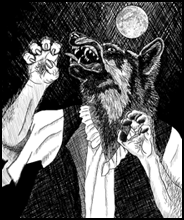The crepuscular life
 The crepuscular life is that of many animals. A very large portion of the animals that inhabit human households (whether or not by invitation) — cats, dogs, deer, rabbits, chinchillas, ferrets, guinea pigs, hamsters, mice, and rats — are crepuscular. The moose is famously crepuscular; visitors to bear country should look for moose during the early morning or late evening hours.
The crepuscular life is that of many animals. A very large portion of the animals that inhabit human households (whether or not by invitation) — cats, dogs, deer, rabbits, chinchillas, ferrets, guinea pigs, hamsters, mice, and rats — are crepuscular. The moose is famously crepuscular; visitors to bear country should look for moose during the early morning or late evening hours.And lest we fall into the trap of noticing only those expressions of life that catch the eye, I hasten to mention another crepuscular animal that is most active at dawn and at dusk:

Whether they are matinal or vespertine, crepuscular animals are responding primarily to selection pressure. Per Wikipedia:
Many predators forage most intensely at night, while others are active at midday and see best in full sun. Thus the crepuscular habit may reduce predation. Additionally, in hot areas, it may be a way of avoiding thermal stress while capitalizing on available light.
 This explains why some crepuscular animals spring to life under bright moonlight. The werewolf legend lies but a short imaginative step away.
This explains why some crepuscular animals spring to life under bright moonlight. The werewolf legend lies but a short imaginative step away.Some real humans, in my experience, also live the crepuscular life. What I have in mind, though, is something more metaphorical. Consider, by way of analogy, the cat. Wedged in size and ferocity between top-level predators and smaller prey, cats are adapted to steer their activities to those portions of the day when they are (1) more likely to snag dinner from the full range of diurnal and nocturnal prey and (2) less likely to become someone else's dinner.
So too with those of us who seek the seams of life, the points of transition between the dark and the light. Welcome to our world, the crepuscular life.












0 Comments:
Post a Comment
<< Home